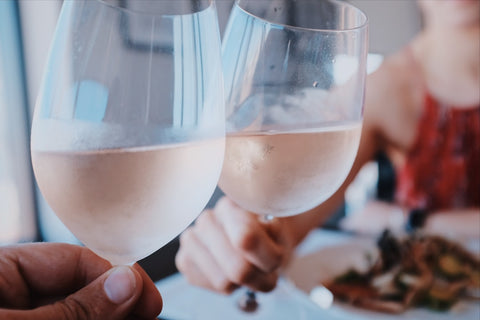How Red Wine is Made: Follow Along Step by Step

Red winemaking is an intricate process that brings together tradition, science, and a touch of artistry. Unlike white wine, red wine gets its vibrant hue from fermenting with grape skins, extracting color, flavor, and tannins. But there’s so much more to red winemaking than meets the eye.
In this guide, we’ll walk you through each step of how red wine is made — from the vineyard to your glass — revealing the secrets that influence quality, taste, and character.
Step 1: Harvest Red Wine Grapes
The journey of red wine begins in the vineyard. Grapes must be harvested at the peak of ripeness because they stop ripening once picked.
- Grapes picked too early result in tart, thin wines.
- Grapes picked too late can create wines that taste overly ripe and lack structure.
At McLaren Vale Cellars, we understand the importance of precise timing during harvest to ensure exceptional wine quality.
Read more about the role of grape varieties in our guide to red wine grapes.
Step 2: Prepare Grapes for Fermentation
After harvest, the grapes are transported to the winery. At this stage, winemakers decide whether to remove the stems or ferment whole grape clusters.
- Stems included: Adds tannin and complexity but can also make the wine taste more astringent.
- Stems removed: Produces smoother, fruit-forward wines.
A small amount of sulfur dioxide is often added to prevent spoilage before fermentation begins.
Discover the science behind sulfites in wine in our article: Are Sulfites in Wine Bad for You?
Step 3: Yeast Starts the Fermentation Process
Yeast is added to the crushed grapes to start fermentation. There are two types of yeast used:
- Commercial yeast: Offers consistency and reliability.
- Natural yeast: Creates unique flavors but can be unpredictable.
Fermentation transforms sugar into alcohol, setting the stage for the wine's character and structure.
Step 4: Alcoholic Fermentation
Fermentation typically lasts 1–2 weeks. During this time, winemakers use techniques like:
- Punching Down: Gently submerging grape skins to extract delicate flavors.
- Pump Overs: Circulating juice over grape skins to extract bold flavors.
These techniques greatly influence the wine's style and body.
Curious about fermentation styles? Explore different fermentation techniques.
Step 5: Press the Wine
After fermentation, the wine is drained from the grape skins. The remaining skins are pressed to extract every last drop of juice, contributing to about 15% more wine yield.
This pressed wine is often more tannic and can be blended back for structure and balance.
Step 6: Malolactic Fermentation (MLF)
In this secondary fermentation, sharp malic acid is converted into smoother lactic acid. This process softens the wine and can add creamy, chocolatey flavors.
Did you know? Chardonnay is one of the few white wines that undergo malolactic fermentation to achieve a buttery flavor.
Learn more about this process in our guide: What is Malolactic Fermentation?
Step 7: Aging (Elevage)
Red wines are aged in various vessels, including:
- Oak barrels: Add flavours like vanilla and spice.
- Concrete or clay tanks: Soften the wine while maintaining freshness.
- Stainless steel tanks: Preserve fruit-forward flavors.
Aging can range from a few months to several years, depending on the wine style.
Explore the art of barrel aging in our guide to oak barrels in winemaking.
Step 8: Blending the Wine
Winemakers often blend different grape varieties or wines from different barrels to achieve the desired flavor profile.
Blending is an art form requiring a keen sense of balance and texture.
Discover famous blends like GSM (Grenache, Shiraz, Mourvèdre) in our article: What Makes a Great Wine Blend?
Step 9: Clarifying the Wine
Before bottling, wine is clarified using fining agents like bentonite clay (vegan-friendly) or egg whites to remove impurities.
Some winemakers skip this step to preserve texture, believing that fining and filtering can strip wine of its character.
Step 10: Bottling and Labeling Wines
Bottling is done carefully to minimize oxygen exposure, with a small dose of sulfur dioxide added to preserve freshness.
The wine is then corked, labeled, and ready for release.
Explore our wine bottle labeling guide.
Step 11: Bottle Aging
Some premium wines continue to mature in bottles for years before reaching their peak. Wines like Brunello di Montalcino or Rioja Reserva are prime examples.
Patience rewards those who cellar wine properly.
Learn more about how to store wine correctly to maximize aging potential.
From Grape to Glass: A Labor of Love
The journey of red wine, from the vineyard to your glass, is a testament to tradition, craftsmanship, and nature’s magic. Every bottle tells a story — a story of soil, sun, and skill.
At McLaren Vale Cellars, we invite you to explore our hand-selected collection of exceptional red wines, crafted with passion and care.
Cheers to your next glass of red wine! 🍷
Explore our full range of premium red wines here.



Comments (0)
There are no comments for this article. Be the first one to leave a message!